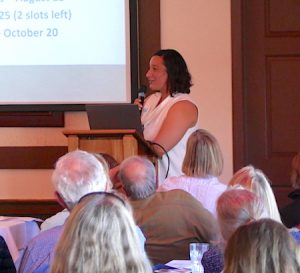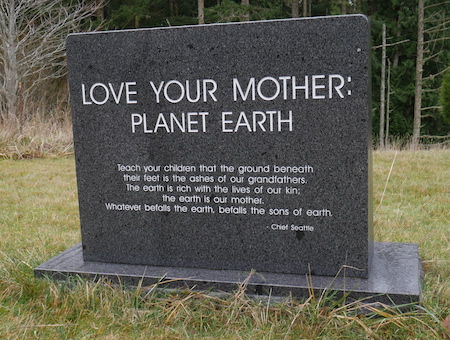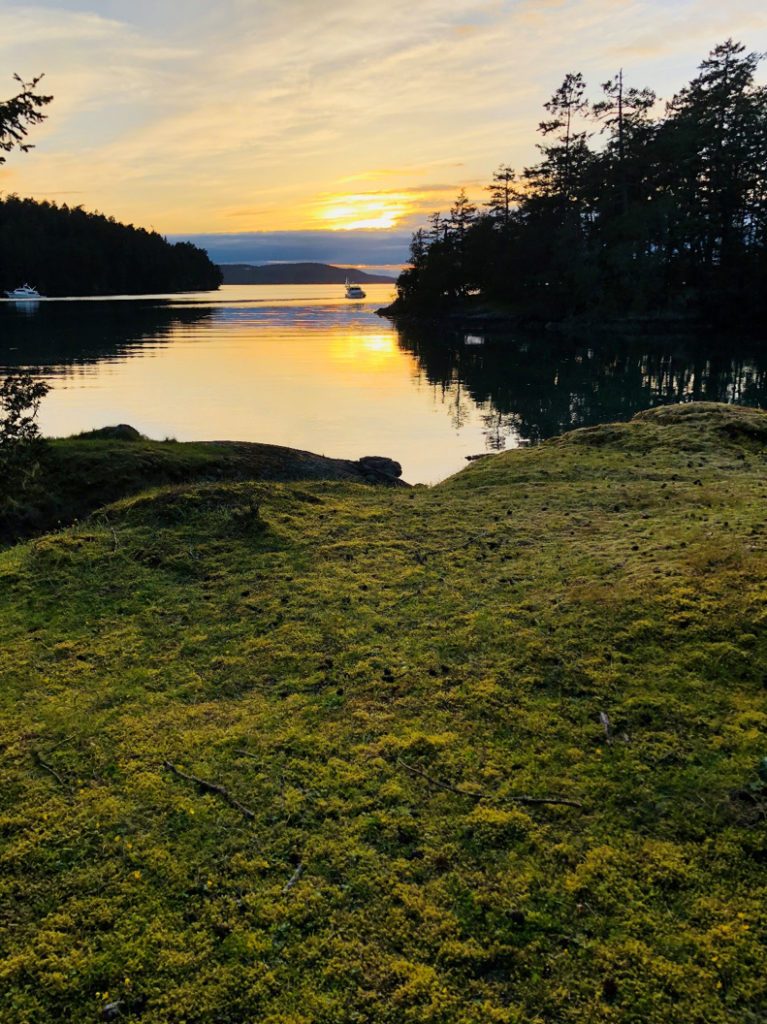Growing Community Conservation, Part I
(This article is adapted from Angela’s presentation at SJPT’s Annual Meeting on May 5. Part one of a two-part series.)

Angela’s Annual Meeting presentation, May 5, 2018
This is truly an exciting time to have joined the Preservation Trust. It’s been just over three months since my family and I made the big move from Kapaa, Kauai, to Shaw Island.
My 17-plus years of experience working in the conservation field in Hawaii had a profound influence on my understanding of our relationship to the land. Fundamental to Hawaiian culture is the understanding that humans and land exist in a reciprocal relationship. We share a common destiny, and the health of each depends on the existence and wellbeing of the other.
Our relationship to the natural environment is, in the literal sense of word, familial.
Living on Shaw Island at the Ellis Family Preserve has profoundly reinforced this understanding. Carved in stone at the entrance to the family cemetery at the Ellis Preserve are these words attributed to Chief Seattle:
“Teach your children that the ground beneath their feet is the ashes of our grandfathers, the earth is rich with the lives of our kin; the earth is our mother. Whatever befalls the earth befalls the sons of earth.”

Chief Seattle inscription at Ellis Family Preserve
I feel blessed to return to the Northwest. It is here that I gained my deep appreciation for the natural world, an appreciation that was forged from an early age. As a young child growing up in the south Puget Sound area, I had many opportunities to spend time in nature, whether attending summer camps or spending weekends with my family exploring national parks and other preserved areas. I sought refuge and sanctuary in the woods, and discovered special, “secret” spots, whether along a mountain stream or a beach cove, that I would return to again and again.
Did you have places like this, where you played and learned and made connections with nature?
These experiences are what inspired our shared interest in conservation. They’re at the root of why we are supporters of the San Juan Preservation Trust today.
When we become intimately familiar with place—through mythology, stories, and through our understanding of the surroundings—we experience that place on a deeper level. There’s a Hawaiian concept that captures this: Wahi Pana. Panacan be translated to mean “legendary” or “storied.” It also means a type of rhythm, a heartbeat, a celebration. Coupled with the word wahi, meaning “place,” Wahi Pana speaks to our being able to sense and tap into the rhythm of a place.
Wahi Pana give us the opportunity to synchronize with nature, with ourselves, and with a cosmic tempo. These treasured places can exist throughout our daily lives—as a secret lunch spot, for example, or a favorite place for watching the sunset. These are our places of inspiration and potential, our places of refuge and renewal.

Sunset at “Picnic Point” on the Ellis Family Preserve
My first experience of a Wahi Pana here in the San Juans is at the Ellis Family Preserve, on a mossy knoll overlooking Parks Bay. An Ellis family member recently told me that they know this spot as Picnic Point, so it’s a place that is historically rich in memories and stories. It provides a wonderful perspective from which to observe the setting sun. Now that the days are longer, I’ve incorporated this as a ritual in my daily routine. The verdant surroundings pulsate with life energy. This special place serves as a daily reminder to me of why our work is so vital.
One of my favorite quotes comes from Aldo Leopold’s book, A Sand County Almanac:“We abuse land because we see it as a commodity belonging to us. When we see land as a community to which we belong, we may begin to use it with love and respect.”
Sometimes we may lose sight of that relationship with the land, as a community to which we belong. This brings me to an idea that is becoming more and more prominent and talked-about in the land-trust world—the idea of community conservation.
Community conservation is a relationship-driven approach that bridges traditional conservation efforts and positive social outcomes. While the traditional acquisition and protection of critical habitat is fundamental to conservation, the acquisition of these lands alone does not necessarily lead to communities that invest in land stewardship, or in continued advocacy for preservation of natural areas.
Community conservation is a critical long-term sustainability strategy, not only for the San Juan Preservation Trust, but for land-conservation organizations and agencies across the country. It’s an approach to doing our work that builds meaningful connections and relationships between a land trust, the community in which we work, and nature. You need all three to be strong and engaged for things to stand in the long term. We are are legally responsible for protecting the land in our care in perpetuity. Now we are coming to terms with what we will need to do, in practice, to ensure and sustain the promise of perpetuity.
We can better see where we want to go by understanding where we’ve been. In next month’s Postcard from the Islands e-newsletter, I’ll explore some ways in which SJPT’s past is a prelude to our future work together.
